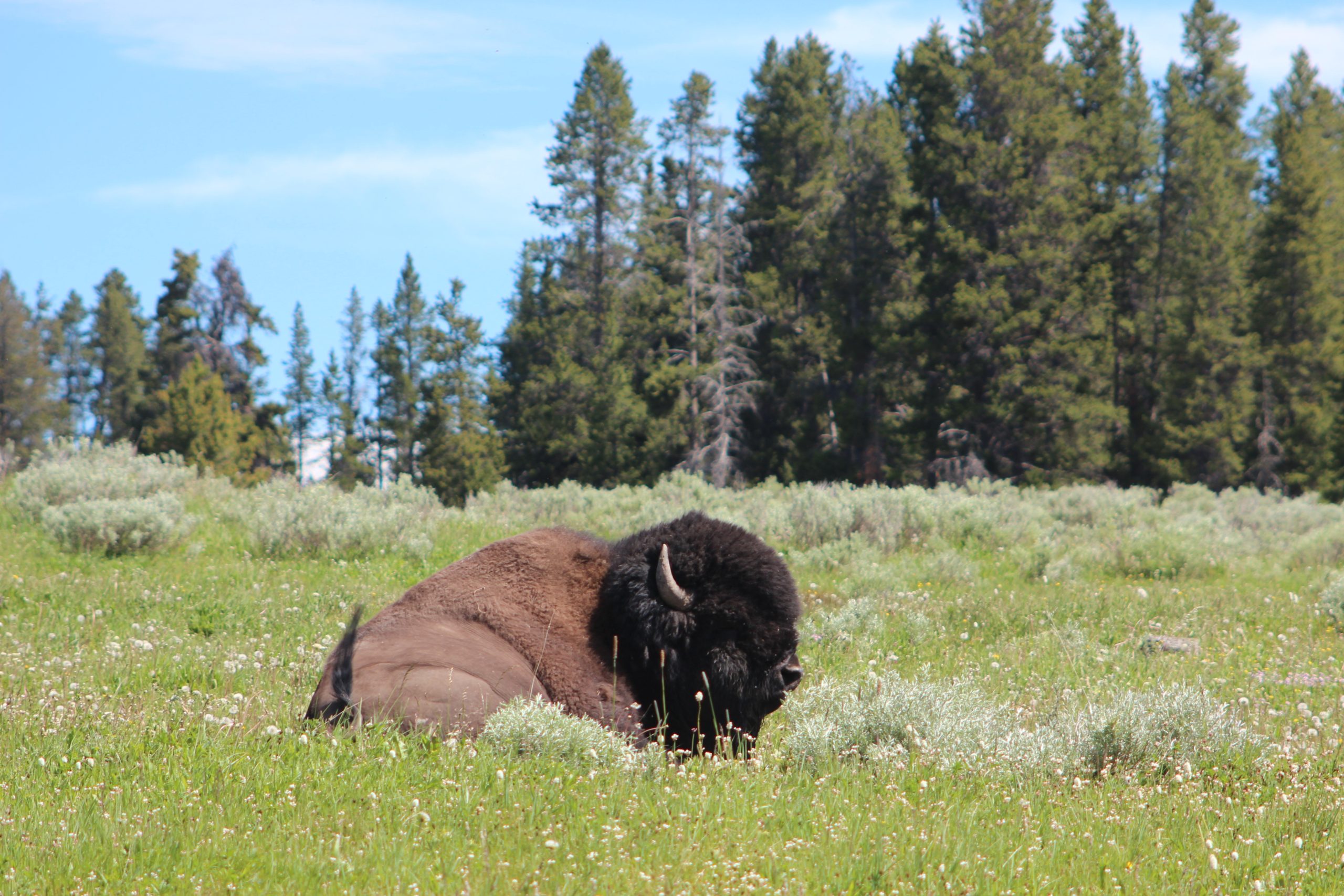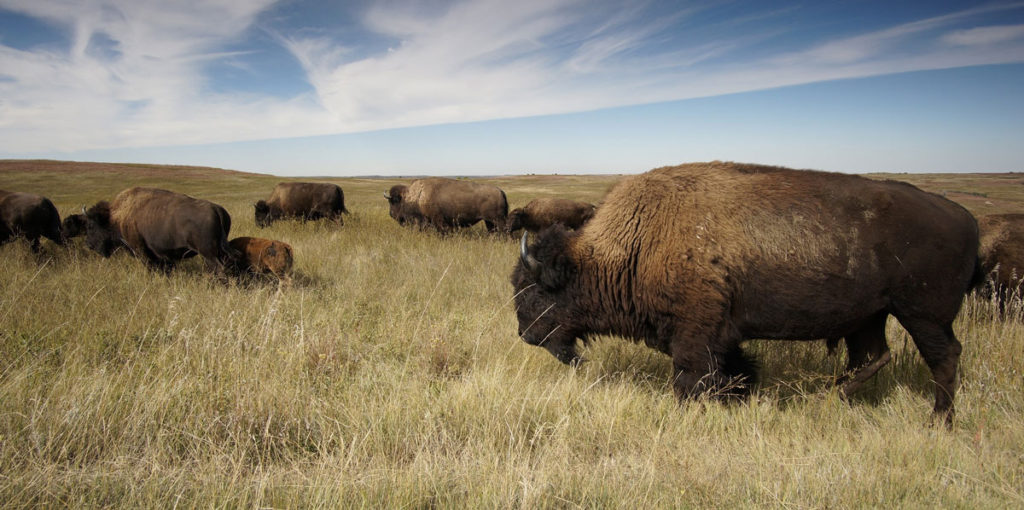Bison and Reconciliation

By Esprit Farmer
Paskwâwimostos, tatanka, mashkodebizhiki, bison. From the languages Cree, Dakota sioux, and Ojibwe/Chippewa. Majestic, massive creatures that roam the plains and are emblematic of Canada’s Indigenous people. These mighty animals may have a dark history, but they also hold a promising future for reconciliation in Canada.
The Ecological Importance of Bison
Bison act as a keystone species in grassland habitats. This means that they are essential to the ecosystem: they have a significant impact on the surrounding plants and animals and help to keep the ecosystem balance in check. This is done both directly, through grazing grass and browsing trees, and indirectly, through fertilization, soil trampling, and the interactions had with other animals.
The health of prairie ecosystems relies on bison. Because of their eating and migration patterns, bison help to spread grass and tree seeds, as well as keep grass growth in check. As they graze the pasture, they provide both nitrogen and fertilizer to the soil in the form of urine and defecation.
This also helps birds and small rodents who rely on grass and healthy soil for habitat and food. It is for these reasons that bison are considered significant contributors to strong and healthy grass, and thus, Saskatchewan’s prairie.

Bison in History
Bison have a long legacy in North America, once dominating the landscape. One account illustrated that at their peak, there may have been 60 million bison roaming the grasslands of Canada, the US, and northern Mexico.
The sheer scale of these herds were unbelievable: Colonel Dodge in his memoirs illustrates that a herd 50 miles wide took five days to pass his campsite. Their size and herd formation made them well-adapted to the prairies.
European colonization changed this narrative: in just a few decades, the bison population was almost completely decimated. In 1902, the population was down to just 3000, isolated to Yellowstone.
The bison were hunted for food, their coat, and their bones. These were commercially used for clothing, glue, fertilizer, and more. Clearly, the colonization of North America relied on bison.
It is argued that beyond the financial benefits of bison, the mass systemic harvesting of bison was also used as a tool of oppression. In 1867, Colonel Dodge said, “Every buffalo dead is an Indian gone.” By controlling and eradicating a major source of food for Indigenous people, colonizers were able to control and subjugate them.
Bison as a form of reconciliation
The destruction of North America’s bison deeply affected Indigenous people and their communities. Indigenous people had many different uses for bison, as it provided them with food, shelter, and tools. From tipis to game dice, and combs to cups, each part of the bison had a use.
But the importance goes beyond this. There is a deep reverence and a spiritual connection to bison. They are considered sacred animals, representing strength, resilience, and a connection to the earth.
Because of this deep respect, the hunt was based on a set of values that would support the survival of the bison population. By never taking more than what was needed and utilizing every part of the animal that was taken, the bison population was kept healthy and strong.
Bison also represent freedom. As elder Lorraine Yuzicapi communicates in the docuseries The Beacon Project, bison are an essential source of sustenance. This creates food sovereignty, a form of freedom and independence that has been denied to many Indigenous communities since the bison slaughter.
The significance of bison, as well as their painful history, shines a light on the fact that bison are a key piece of reconciliation in Canada. The connection between Indigenous people and bison allows for a reconnection to the land and creates an opportunity to heal the past.
Bison reconciliation takes many forms. Across southern Saskatchewan, First Nation reserves have begun the efforts to incorporate bison back onto the prairie. In doing so, communities are building a foundation for food sovereignty, revitalizing their spiritual connection to the buffalo, and reclaiming an integral part of their culture. Beyond this, reintroducing bison to these lands will bring health and vitality to the prairie grassland habitat.



Indigenous Guardians Program
CPAWS Saskatchewan has partnered with Mistawasis Nêhiyawak to protect, conserve, and revive the dwindling population of the Sturgeon River Plains Bison herd through the Indigenous Guardians Program.
The goal of the Guardians Program is for the community to relearn and connect to the land and the nature of the buffalo while working to protect the endangered Sturgeon River Plains herd. Mistawasis’ long-term vision is to bring a new herd to their lands. These objectives mark important steps for Mistawasis as they continue to move towards self-determination and self-governance.
Mistawasis Nêhiyawak and CPAWS Saskatchewan are also committed to promoting the Buffalo Treaty. This Treaty is a Nation-to-Nation Treaty that follows the spirit and intent of ancient interactions between Indigenous groups as they shared the Great Plains and lived nomadic lives that followed the buffalo across the continent.
The Treaty returns buffalo consciousness to 21st Century thought and action, and explores ways to protect existing herds and to reintroduce buffalo to traditional Indigenous lands.
Signed by Mistawasis Nêhiyawak and CPAWS Saskatchewan, the Buffalo Treaty guides and supports the Guardians Program and is focused on bridging the gap between Indigenous knowledge and science in order to rehabilitate bison across North America. The Buffalo Treaty represents an important step in the international cooperation of bison restoration.



Resources:
Our keystone species: Bison and their restoration | The Human Footprint
Plains First Nations – spiritual beliefs, a connection to animals
The Beacon project
Why Is The Bison A Keystone Species? – North American Nature
